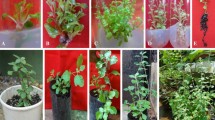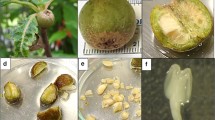Summary
The endangeredPhebalium equestre D. A. Cooke and the rarePhebalium hillebrandii J. H. Willis were propagated in vitro using shoot tips and nodal segments as explants. For each species, shoot proliferation was initiated on de Fossard MZZM (Medium levels of minerals, Zero auxins, Zero cytokinins and Medium levels of sucrose, growth factors, and amino acids) medium supplemented with 1 µM benzyladenine. ExcisedP. equestre shoots initiated roots when cultured on MZZM medium containing 60 µM 2,4-dichlorophenoxyacetic acid, whileP. hillebrandii shoots required LZZL (Low levels of minerals, Zero auxins, Zero cytokinins and Low levels of sucrose, growth factors, and amino acids) medium containing 10 µM 2,4-D for maximal root initiation. Both species required transfer to MZZM medium without growth regulators after 2 wk to allow root initials to develop and grow. Plantlets were successfully transferred to soil with 80% survival after 2 mo.
Similar content being viewed by others
References
Ault, J. R. In vitro propagation ofEriostemon myoporoides andEriostemon “Stardust.” HortScience 29:686–688; 1994.
Blakesley, D.; Weston, G. D.; Hall, J. F. The role of endogenous auxin in root initiation. Part 1: Evidence from studies on auxin application, and analysis of endogenous levels. Plant Growth Regul. 10:341–353; 1991.
Bramwell, D. The role ofin vitro cultivation in the conservation of endangered species. In: Hernandez Bermejo, J. E.; Clemente, M.; Heywood, V., eds. Conservation techniques in botanic gardens. Koenigstein, Germany: Koeltz Scientific Books; 1990:3–15.
Briggs, J. D.; Leigh, J. H. Rare or threatened Australian plants. Australian National Parks and Wildlife Service, Special Publication [14]; 1988.
de Fossard, R. A.; Myint, A.; Lee, E. C. M. A broad spectrum tissue culture experiment with tobacco (Nicotiana tabacum) pith tissue callus. Physiol. Plant. 31:125–130; 1974.
Fay, M. F. Conservation of rare and endangered plants using in vitro methods. In Vitro Cell. Dev. Biol. 28P:1–4; 1992.
Jusaitis, M. Endangered plants hold horticultural potential. Australian Hortic. 90(7):32–35; 1992.
Murashige, T.; Skoog, F. A revised medium for rapid growth and bioassays with tobacco tissue cultures. Physiol. Plant. 15:473–497; 1962.
Plummer, J. A.; de Fossard, R. A. The influence of plant hormones and growth factors on growth ofEriostemon australasius Pers. in tissue culture. Proceedings of the International Plant Propagators’ Society 31:295–303; 1981.
Whitehorne, G. J.; McIntyre, D. K. A method for breaking seed dormancy inBoronia spp.,Eriostemon spp. and other native Australian species. Proceedings of the International Plant Propagators’s Society 25:291–294; 1975.
Author information
Authors and Affiliations
Rights and permissions
About this article
Cite this article
Jusaitis, M. In vitro propagation ofPhebalium equestre andPhebalium hillebrandii (rutaceae). In Vitro Cell Dev Biol - Plant 31, 140–143 (1995). https://doi.org/10.1007/BF02632009
Received:
Accepted:
Issue Date:
DOI: https://doi.org/10.1007/BF02632009




